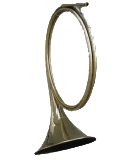
Paxman was established at the turn of the century (20th) by Harry Paxman, but did not start production of horns until 1945, when no more than twelve instruments a year were made.
1950 saw the arrival in England of Richard Merewether, a professional horn player whose career had started with the Sydney Symphony Orchestra. As his career in this country progressed, he found himself specialising more and more in the high register of the instrument. He had been working on ideas of horn design for a number of years and had researched areas of physics which he thought to be fundamental to the successful design and manufacture of such instruments. He approached Robert Paxman with these ideas, and persuaded him to build horns in f-alto and F/f-alto.
These instruments were so successful that Merewether and Paxman continued their association and went on to developed a range of over 50 models. They became a unique duo, known to players all over the world as the figureheads of a highly skilled team. Fifty years of research and development have produced the instruments that put Paxman at the forefront of horn manufacture. Instruments that are much sought after by players world-wide.
Paxman did not take their position as one of the world's leading horn makers lightly, and are constantly making great efforts to maintain their innovative role. Players' comments and opinions are actively sought, and there is continuous research and incorporation of advantageous modifications. Special requests are always undertaken where technically possible.
Each horn is carefully assembled and meticulously checked after manufacture to ensure that it meets the high standards expected of a Paxman insument.
In 1993 Robert Paxman was awarded the MBE for his services to the musical instrument manufacturing industry, and while he remains Chairman of Paxman, the day to day running of the company is now in the hands of the Managing Director, Chris Huning.
The London centre of Paxman's activities has moved over the years from the early days in Gerrard Street, via a long period in Covent Garden, to the present premises in Union Street, south of the river Thames.
The light and airy showroom - the only establishment in England dedicated soley to horn players - holds an enormous range of new and second-hand instruments of various makes.
For as long as there has been a Paxman shop there has been an unrivalled on-site repair facility. From 8.30am until 4.00pm advice is always available, and if work load allows it is often possible to obtain an on-the-spot repair.
Paxman horns have traditionally been assembled in a factory outside London, with the finishing and setting up for the customer completed in the London shop. In 1994 the factory moved to its present location in Staplehurst, Kent. John Turner and his team are a vital part of Paxman and their high standards of craftsmanship are fundamental to the outstanding reputation of Paxman instruments throughout the world.
Tradition and progress:
Through the years, the making of handcrafted instruments continually developed, to where now, modern manufacturing methods favourably supplement traditional, handmade methods. Improvements are constantly being made in close collaboration with experienced orchestral musicians. New scientific developments in the manufacturing of instruments are constantly being evaluated and put to use.
Tradition and progress are the reasons for Alexander instruments being of such superior quality. Satisfied customers are an acknowledgement of product excellence. Thousands of thank-you letters from all over the world ascertain to this fact.
Alexander horns meet the highest demands of horn players from some of the greatest orchestras in the world. Why is it that so many musicians, from beginners to advanced professionals, rely on Alexander instruments?
Linton House, 164 -180 Union Street,
London SE1 0LH, UK
Office/Shop: (0)20 7620 2077,
Fax: (0)20 7620 1688,
Workshop: (0)20 7620 1990
Shop open Monday - Friday 9.30 - 17.30 and Saturday 10.00 - 17.00
Email:

In 1782, the musical instrument maker Franz Ambros Alexander came to Mainz, the world famous "Gutenberg-city" on the Rhein. After being accepted to the guild of craftsmen, he started a business manufacturing fine musical instruments. Today - more than 200 years later - the company "Gebr. Alexander" is still owned and operated by the founder?s descendants.



